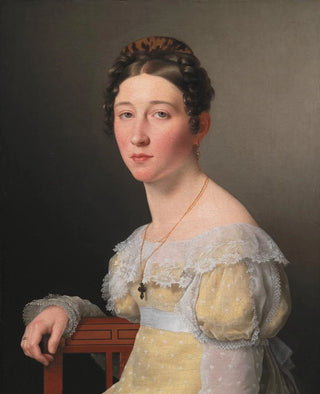Art print | Portrait of Emilie Henriette Massmann fiancée of Frederik Wilhelm Caspar von Benzon - Christoffer Wilhelm Eckersberg


View from behind

Frame (optional)
Portrait of Emilie Henriette Massmann, fiancée of Frederik Wilhelm Caspar von Benzon - Christoffer Wilhelm Eckersberg – Engaging introduction
In the vast panorama of art history, some works transcend their era to become timeless witnesses of beauty and human emotion. The portrait of Emilie Henriette Massmann, fiancée of Frederik Wilhelm Caspar von Benzon, created by Christoffer Wilhelm Eckersberg, is a perfect example. This painting, both delicate and powerful, captures the very essence of its model while revealing the subtleties of a period marked by romanticism and the pursuit of authenticity. Through this masterpiece, Eckersberg invites us to delve into a world where every brushstroke tells a story, where each exchanged gaze evokes deep and universal feelings.
Style and uniqueness of the work
Eckersberg's style is distinguished by his ability to combine realism and idealization. In the portrait of Emilie Henriette Massmann, the artist manages to capture not only her physical features but also her spirit and personality. Light plays a crucial role in this piece, gently illuminating the young woman's face and highlighting the texture of her clothing. The colors, carefully chosen, oscillate between softness and intensity, creating a visual harmony that draws the eye and holds attention. Every detail, from the sparkling jewelry to the sparkle in her eyes, is meticulously crafted, demonstrating undeniable technical mastery. This portrait is not merely a simple representation but rises to a level of expression where the artist's sensitivity blends with the beauty of the subject.
The artist and his influence
Christoffer Wilhelm Eckersberg, often regarded as the father of Danish realism, made his mark on his era through an innovative approach to portrait painting. Trained at the Royal Danish Academy of Fine Arts in Copenhagen, he was influenced by the great European masters while developing a style that was uniquely his own. His work not only redefined portrait standards but also paved the way for a new generation of artists seeking to capture everyday life with renewed authenticity. Through his

Matte finish

View from behind

Frame (optional)
Portrait of Emilie Henriette Massmann, fiancée of Frederik Wilhelm Caspar von Benzon - Christoffer Wilhelm Eckersberg – Engaging introduction
In the vast panorama of art history, some works transcend their era to become timeless witnesses of beauty and human emotion. The portrait of Emilie Henriette Massmann, fiancée of Frederik Wilhelm Caspar von Benzon, created by Christoffer Wilhelm Eckersberg, is a perfect example. This painting, both delicate and powerful, captures the very essence of its model while revealing the subtleties of a period marked by romanticism and the pursuit of authenticity. Through this masterpiece, Eckersberg invites us to delve into a world where every brushstroke tells a story, where each exchanged gaze evokes deep and universal feelings.
Style and uniqueness of the work
Eckersberg's style is distinguished by his ability to combine realism and idealization. In the portrait of Emilie Henriette Massmann, the artist manages to capture not only her physical features but also her spirit and personality. Light plays a crucial role in this piece, gently illuminating the young woman's face and highlighting the texture of her clothing. The colors, carefully chosen, oscillate between softness and intensity, creating a visual harmony that draws the eye and holds attention. Every detail, from the sparkling jewelry to the sparkle in her eyes, is meticulously crafted, demonstrating undeniable technical mastery. This portrait is not merely a simple representation but rises to a level of expression where the artist's sensitivity blends with the beauty of the subject.
The artist and his influence
Christoffer Wilhelm Eckersberg, often regarded as the father of Danish realism, made his mark on his era through an innovative approach to portrait painting. Trained at the Royal Danish Academy of Fine Arts in Copenhagen, he was influenced by the great European masters while developing a style that was uniquely his own. His work not only redefined portrait standards but also paved the way for a new generation of artists seeking to capture everyday life with renewed authenticity. Through his






